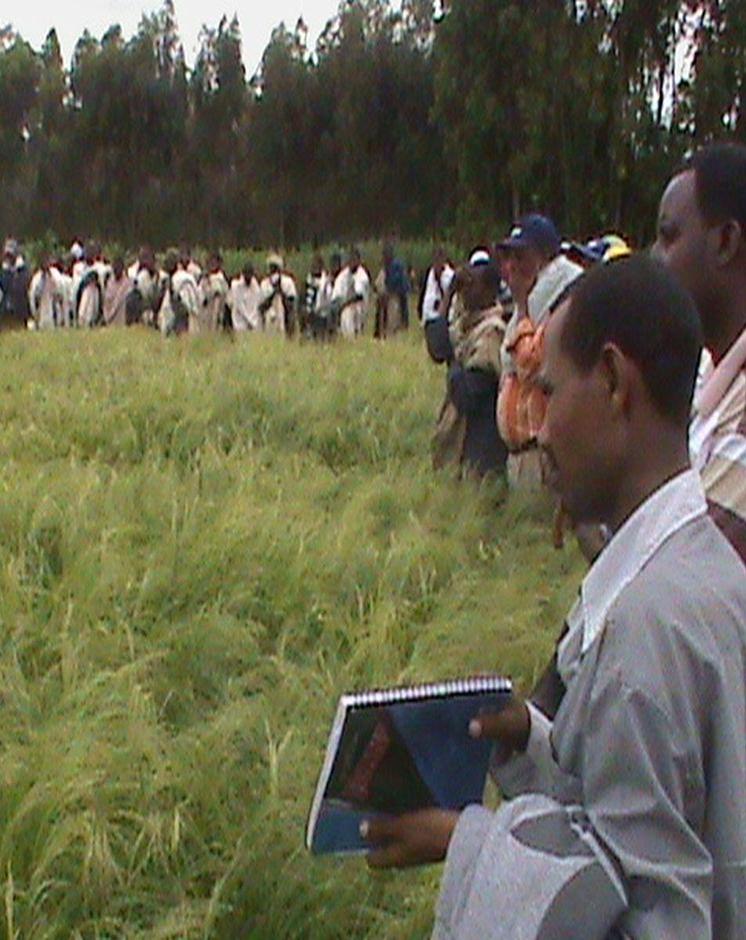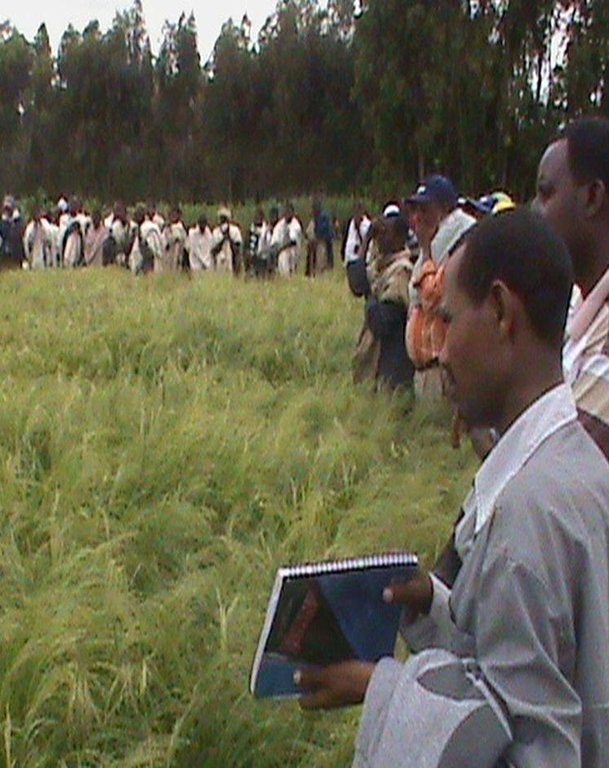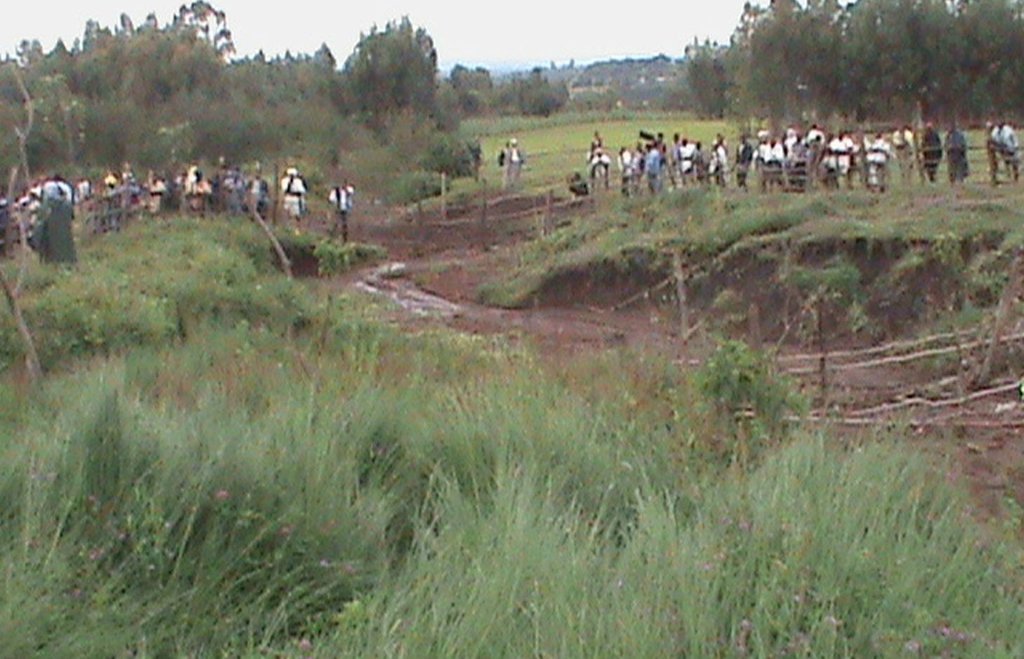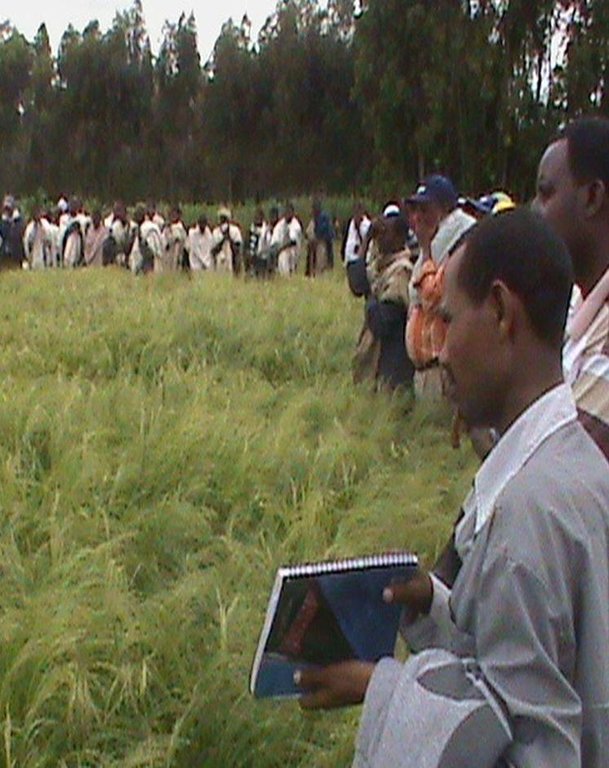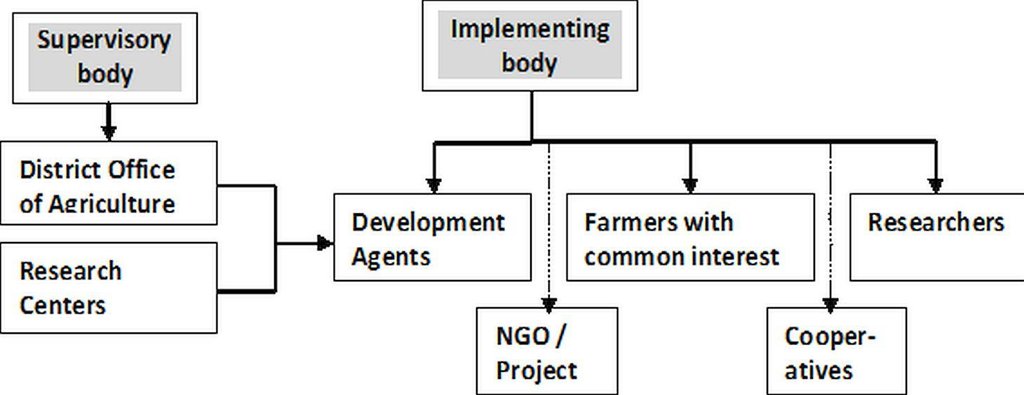Farmer-Research-Extension Group (FREG) [Ethiopia]
- Creation:
- Update:
- Compiler: Gizaw Desta Gessesse
- Editor: –
- Reviewer: Fabian Ottiger
Yearsoader temeramari buden (Amharic)
approaches_2496 - Ethiopia
View sections
Expand all Collapse all1. General information
1.2 Contact details of resource persons and institutions involved in the assessment and documentation of the Approach
Name of the institution(s) which facilitated the documentation/ evaluation of the Approach (if relevant)
Water and Land Resource Centre (WLRC) - Ethiopia1.3 Conditions regarding the use of data documented through WOCAT
When were the data compiled (in the field)?
26/05/2014
The compiler and key resource person(s) accept the conditions regarding the use of data documented through WOCAT:
Ja
1.4 Reference(s) to Questionnaire(s) on SLM Technologies
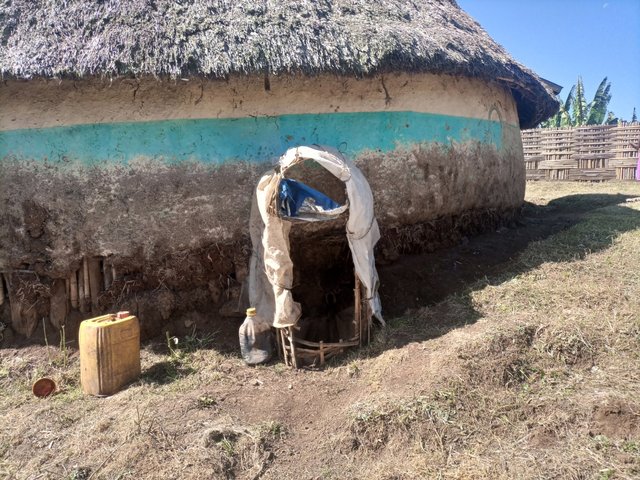
Livestock Urine Collection and Use [Ethiopia]
Collection of livestock urine allows resource-poor farmers to capture nutrient-rich livestock waste and use it to substitute urea fertilizer. It is a liquid organic product that restores soil fertility and pest management.
- Compiler: GERBA LETA
2. Description of the SLM Approach
2.1 Short description of the Approach
Farmer-Research-Extension Group (FREG) is a grass root level platform aims to bridge gaps on agricultural technology transfer between research and extension linkage and provide a platform of 20-30 members from research, extension and farmer for their joint learning and active participatory role in agricultural technology evaluation and dessimination.
2.2 Detailed description of the Approach
Detailed description of the Approach:
Aims / objectives: FREG aims to facilitate the selection and transfer of agricultural technologies to end users through active participation and coordinated efforts of research-extension and farmer together. The objectives of FREG are: 1) evaluating and selecting improved agricultural technologies through participatory processes at field level, 2) demonstrating improved agricultural technologies to FREG members and other non-member land users in the villages, 3) facilitating farmer to farmer knowledge and technology exchange for faster and wider dissemination and adoption
Methods: In FREG, research takes initiation to facilitate the formation. The group is expected to identify and prioritize problems of their locality on its own and research and extension organizations could take facilitation to form or organize groups based on specific objectives. If the intention is to provide a range of technological options to fit needs and interests of farmers, it can be best developed with participation and through knowledge sharing among stakeholders (research, extension and farmer). Thus, group formation is based on individual and group interests. Those farmers who have similar interests are organized into a group based on proximity including both male and women farmers. Next, the group establish norms, share responsibility, design activity plan, and implement activities. The group meets regularly to evaluate performance of technologies at different stages. During each meeting, it is critical to visit on-farm activities of individual members and assess the relative performance. They develop their own criteria to rank and select the best technologies. Finally, they participate in field days and decide the best technologies for scale up to wider areas.
Stages of implementation: 1. Conduct awareness meeting of farmers about the available technologies for demonstration and scale up and their merits compared to the existing technologies in the hands of farmers.
2. Based on the awareness creation, collect the demands and interests of farmers in which of the technology options they want to involve. Organize into groups according to common interests.
3. Prepare and conduct training about the characteristics of available technologies, procedures of on-farm implementation and evaluation, farmer to farmer technology transfer, and work norms
4. FREG members develop their working norms, decide on the period of meetings, and develop plan of activities
5. Implement on-farm activities and evaluate the performance of planned activities on regular basis
6. Evaluate and rank the technology options based on their own criteria in order to select the best technologies
7. Organize field days to demonstrate and exchange the results of technology options to other non-member farmers and stakeholders. The technologies selected through FREG participatory evaluation procedures need to be supported with research evidences by ARARI.
8. Finally, each member farmer who is involved in on-farm technology evaluation took the responsibility to transfer the selected technology to at least 3-5 other farmers in his locality in order to facilitate quick dissemination, scaling up.
Role of stakeholders: Farmer: The farmers who have common interest on a given technology is responsible to lead the participatory technology selection
Development agents/extension: they should play facilitation and motivation role and help to encourage farmers to become member of FREG. They also follow up whether the FREG accomplish the planned activities and attend regular meetings
Research: research is involved in demonstration of technologies, in the initiation and establishment of FREG and plays a role of facilitation and technology supply. Research need to organize field days and advice other stakeholders to participate in the process
Project/WLRC: Provide material and technical support for the FREG and participate in the meetings and field days
Other stakeholders: The involved actors in the area should actively participate as a FREG member and during field days.
2.3 Photos of the Approach
2.5 Country/ region/ locations where the Approach has been applied
Country:
Ethiopia
Region/ State/ Province:
Amhara National Regional State
Further specification of location:
Bahir Dar Zuria, Dembecha, Mecha, Yilmna Densa, Dessie Zuria, Basona Worana
2.6 Dates of initiation and termination of the Approach
Indicate year of initiation:
2005
2.7 Type of Approach
- project/ programme based
2.8 Main aims/ objectives of the Approach
The Approach focused mainly on other activities than SLM (Participatory technology evaluation and selection, awareness creation, training, field visits, field days)
The main objective of FREG is to facilitate the participation and involvement of farmers, researchers and extension agents together in technology evaluation, selection and dessimination.
The SLM Approach addressed the following problems: The main problems targeted to address by implementing FREG approach are: low dissemination and adoption of agricultural and natural resource management technologies; linkage gap between research, who generate technologies, and extension who transfer and disseminate technologies; and low participation and involvement of farmers in technology development and selection processes.
2.9 Conditions enabling or hindering implementation of the Technology/ Technologies applied under the Approach
availability/ access to financial resources and services
- hindering
Low capacity of farmers to afford and use improved technologies
Treatment through the SLM Approach: The approach allows options of in-kind exchange, transfer and dissemination of technologies from farmer to farmer without incurring much cost to them
institutional setting
- hindering
Inadequate linkage between research and extension that lead to low supply and transfer of technologies
Treatment through the SLM Approach: The FREG is the best link at grass root level where the demand (extension-farmer) and supply (research) can effectively interface
legal framework (land tenure, land and water use rights)
- hindering
The existing land ownership, land use rights / water rights hindered a little the approach implementation Since FREG approach is implemented on individual farm plots, entitlement of individual land use right is essential to invest on new agricultural technologies. At same time, water use right has contributed a lot to implement technologies working under irrigated and water harvesting systems. For example, if farmers are not allowed to dig shallow wells and divert streams it was not able to demonstrate and implement home garden in all watersheds and chickpea varieties at Debre Yacob
knowledge about SLM, access to technical support
- hindering
Lack of information about availability of technologies and inadequate participation of farmers in technology evaluation and selection processes that partly result in low adoption of existing technologies.
Treatment through the SLM Approach: The FREG approach provides choice of technologies for farmers and extension agents and take part in the evaluation and selection of technologies that fit to the system for wider adoption
3. Participation and roles of stakeholders involved
3.1 Stakeholders involved in the Approach and their roles
- local land users/ local communities
Individual land users who have common interest on specific technology
Land users are active members and take the leading responsibility of the process
- SLM specialists/ agricultural advisers
Agricultural specialists and development agents
- researchers
Researchers has the role to facilitate and provide technologies
- local government
The development agent together with kebele adminstration, District Agriculture Office Cooperative Agents for implementation and supervision
- national government (planners, decision-makers)
They were involved in the monitoring and evaluation stage
If several stakeholders were involved, indicate lead agency:
In FREG, both men and women can be members. Women play a great role in selecting technologies specially technologies related to food processing aspects
3.2 Involvement of local land users/ local communities in the different phases of the Approach
| Involvement of local land users/ local communities | Specify who was involved and describe activities | |
|---|---|---|
| initiation/ motivation | passive | Land users has no involvement in the initiation of the approach. Land users are part of the process after the planning phase. |
| planning | interactive | At planning stage of the approach, land users' are needed to express their interests and needs of technology options, and their interest to form a group. Land users participate by expressing their technology needs once information about available technology options is provided by the researchers and development agents. |
| implementation | interactive | Land users are expected beeing actively involved in every stage of the implementation and take the leading responsibility to all activities such as site selection, seed bed preparation, planting, cultivation, harvesting and reporting the productivity. |
| monitoring/ evaluation | interactive | Land users are responsible to regularly evaluate the technologies and select the best for promotion and further scale up activities |
| Research | interactive | In the FREG approach, participatory technology evaluation and selection is the key element. Thus the land users are allowed to evaluate and select best and suitable ones among several options |
3.3 Flow chart (if available)
Description:
The district office of agriculture and research centers within ARARI are the supervisory bodies for the implementation of the FREG approach. The main implementer are the member farmers in the group, the researcher and development agent at kebele level. Depending on the availability and interest, NGOs/ Projects and cooperative agents are involved in the implementation of the process.
Author:
Gizaw Desta (WLRC, P.O.Box 8707, Addis Abeba, Ethiopia)
3.4 Decision-making on the selection of SLM Technology/ Technologies
Specify who decided on the selection of the Technology/ Technologies to be implemented:
- mainly land users, supported by SLM specialists
Explain:
Different options of adapted technologies are supplied from research and the farmers can decide and choose the type of technology for demonstration and scale up
Decisions on the method of implementing the SLM Technology were made by mainly by SLM specialists with consultation of land users. Researchers and development agents with active participation of the FREG member farmers decide on the method of implementation
4. Technical support, capacity building, and knowledge management
4.1 Capacity building/ training
Was training provided to land users/ other stakeholders?
Ja
Specify who was trained:
- land users
- field staff/ advisers
- Other development agents are involved in cooperatives and other agr. development actions
If relevant, specify gender, age, status, ethnicity, etc.
It includes all land users who are members of FREG including women.
Form of training:
- on-the-job
- farmer-to-farmer
- demonstration areas
Subjects covered:
Awareness creation and characteristics of the technology, merits of new technologies compared to locally available and adapted technologies, procedures of implementing the technology evaluation and selection, the participation and involvement of FREG members at each stage of the implementation are contents of the training for FREG members before they start implementation.
Development agents and some experts from the district as well as project/NGO offices are contributing to the trainings about the implementation procedures and monitoring and evaluation activities.
4.2 Advisory service
Do land users have access to an advisory service?
Ja
Specify whether advisory service is provided:
- at permanent centres
Describe/ comments:
Name of method used for advisory service: Participatory Demonstration and Training Extension System (PADETES); Key elements: Training and awareness creation of farmers in FTCs , Provision of package of technologies, demonstrations in the Farmer Training Centers (FTC) and experience sharing visits, On job training; The method gives high emphasis to training and to some extent practical demonstrations supported with experience
sharing visits but less emphasis to advisory of farmers on spot
Advisory service is quite adequate to ensure the continuation of land conservation activities; The government service at Kebele level is adequate to ensure the implementation of FREG approach through active involvement of the development agents.
4.3 Institution strengthening (organizational development)
Have institutions been established or strengthened through the Approach?
- yes, moderately
Specify the level(s) at which institutions have been strengthened or established:
- local
Specify type of support:
- capacity building/ training
Give further details:
Moderate support with awareness creation, training, and supply of some equipments. The local institutions like FREG and Farmer Training Centers (FTCs) are supported by training, and training and demonstration aid facilities
4.4 Monitoring and evaluation
Is monitoring and evaluation part of the Approach?
Ja
Comments:
bio-physical aspects were ad hoc monitored by government, land users through observations; indicators: growth performance of varieties or breeds, occurrence of disease and pests
bio-physical aspects were regular monitored by project staff, government through measurements; indicators: amount of inputs applied and labor, production and productivity of comparative technologies by WLRC and ARARI
socio-cultural aspects were regular monitored by project staff, government through measurements; indicators: Change in attitude of technology use, collective action within the group, productivity and economic benefits, exchange of knowledge and technology, transfer and dissemination rate measured jointly by WLRC and ARARI
area treated aspects were ad hoc monitored by project staff, government, land users through observations; indicators: Type of technology, number of users per technology, area covered by the technology
area treated aspects were regular monitored by project staff, government through measurements; indicators: Type of technology and number of users per technology by WLRC
There were several changes in the Approach as a result of monitoring and evaluation: After the monitoring and evaluation, the number of users increase, high demand and request for additional technologies, improved management of the technology were observed.
There were few changes in the Technology as a result of monitoring and evaluation: It sometimes occurs where there are more superior new technologies. For example, Faba Bean varieties were changed by superior one called Wolki variety.
4.5 Research
Was research part of the Approach?
Ja
Specify topics:
- economics / marketing
- technology
Give further details and indicate who did the research:
Research play role of initiation of the approach, facilitate the processes, take part in the implementation, monitoring and evaluation, advisory services, supply of the technologies demanded by FREG members, and evaluate the costs and benefits of the demonstrated technologies. The research centers in 2.3.1.1 (i.e., five research centers within the Amhara Region Agricultural Research Institute, ARARI) are fully responsible to conduct demonstrations, pr-extension dissemination of technologies and socio-economic research activities through the FREG
Research was carried out on-farm
5. Financing and external material support
5.1 Annual budget for the SLM component of the Approach
If precise annual budget is not known, indicate range:
- 100,000-1,000,000
Comments (e.g. main sources of funding/ major donors):
Approach costs were met by the following donors: local government (district, county, municipality, village etc) (Research centers (5 research centers within the Amhara Region Agricultural Reserch Institute, ARARI) provide capacity building through training and field visits, and supply of inputs (improved varieties) land allocation, fertilizer, labor): 15.0%; local community / land user(s) (land users contribute fertilizer, labor and allocate land for implementation): 85.0%
5.2 Financial/ material support provided to land users
Did land users receive financial/ material support for implementing the Technology/ Technologies?
Ja
5.3 Subsidies for specific inputs (including labour)
- agricultural
| Specify which inputs were subsidised | To which extent | Specify subsidies |
|---|---|---|
| seeds | fully financed | |
| fruits, tree seedlings, breeds | fully financed | |
If labour by land users was a substantial input, was it:
- voluntary
Comments:
Labor to implement on-farm activities is covered by the FREG member or in group voluntarily
5.4 Credit
Was credit provided under the Approach for SLM activities?
Ja
Specify conditions (interest rate, payback, etc.):
Credit is only partly available for specific technology types such as sheep breeds, fattening, potato seed storage and cooperative establishments, apiary
6. Impact analysis and concluding statements
6.1 Impacts of the Approach
Did the Approach help land users to implement and maintain SLM Technologies?
- No
- Yes, little
- Yes, moderately
- Yes, greatly
The approach helps to improve sustainable land management indirectly. Farmers who practiced improved technologies increase their productivity per unit area and are thereby capable to purchase more inputs and apply improved sustainable land management technologies. Those who earn high income can afford to invest on sustainable land management.
Did the Approach empower socially and economically disadvantaged groups?
- No
- Yes, little
- Yes, moderately
- Yes, greatly
Youth groups who are organized to provide services to farmers by operating and threshing teff and finger millet using introduced threshers gain some benefits. Women FREG households involved in sheep, poultry and energy saving stove production activities got benefit and improved their situation
Did the Approach improve issues of land tenure/ user rights that hindered implementation of SLM Technologies?
- No
- Yes, little
- Yes, moderately
- Yes, greatly
The problem is unlikely to be overcome in the near future. The land ownership or land use rights is highly associated with increase in population and then lead to land fragmentation. This implies the need for policy actions on land use rights.
Did other land users / projects adopt the Approach?
- No
- Yes, little
- Yes, moderately
- Yes, greatly
The approach and/or technology transfer and utilization is gradually expanded to other villages and adjacent watersheds through farmer to farmer technology transfer and share of experiences during field days.
Did the Approach lead to improved livelihoods / human well-being?
- No
- Yes, little
- Yes, moderately
- Yes, greatly
Using the approach, FREG members and some non-members particularly those who were involved in the production of teff, potato, wheat, barley, and faba bean had improved varieties; in the production of improved breeds of sheep and poultry they hac improved their livelihood situation. Some land users who also produced potato and forage seeds for sale were also benefited. In some watersheds, crop damages by rodent flocks were extremely minimized. FREG members who took part in manual maize sheller and multi-crop thresher technology promotion activities were highly benefited in saving high labor requirement.
Did the Approach help to alleviate poverty?
- No
- Yes, little
- Yes, moderately
- Yes, greatly
FREG members who were involved in the production of improved agricultural technologies are gradually going to improve their poverty situation.
6.2 Main motivation of land users to implement SLM
- increased production
The immediate interest and objectives of farmers is to increase productivity per unit of their land
- payments/ subsidies
Initially some have been motivated by giving them access to improved technologies & inputs
- well-being and livelihoods improvement
They realized that the approache ultimately can improve production, income and livelihood
6.3 Sustainability of Approach activities
Can the land users sustain what has been implemented through the Approach (without external support)?
- yes
If yes, describe how:
The technologies remain for long in the hands of FREG member farmers. They continue to produce the technology and disseminate in the area through farmer to farmer dissemination system. FREG members acquire capacity to access new technologies from research, extension and input supply seed agencies using the established linkage mechanism. Finally, these ensure sustainability of the approach that aim the transfer and adoption of technologies by farmers
6.4 Strengths/ advantages of the Approach
| Strengths/ advantages/ opportunities in the land user’s view |
|---|
| Increase the supply of new technologies. (How to sustain/ enhance this strength: Strengthen and expand FREG approach, and the role of research and seed enterprises.) |
| Strengths/ advantages/ opportunities in the compiler’s or other key resource person’s view |
|---|
| Improves communication and information exchange thereby improving social relations. (How to sustain/ enhance this strength: Can be used as an entry point for social learning a process by which stakeholders in a group learn how to innovate and adopt in response to changing social and environmental conditions.) |
| Increase productivity and efficiency, and empowers farmers economically. (How to sustain/ enhance this strength: Provide variety of technology options every year based on their needs and interests.) |
| It gives an opportunity for the research system to scale up/out shelved technologies and increase the visibility of the research outputs. (How to sustain/ enhance this strength: Encourage research programmes of the research system to use the FREG approach for any technology dissemination and outreach services.) |
| Strengthen the linkage between research and extension at grass root level. (How to sustain/ enhance this strength: Empower the FREG to influence the research agenda and extension system so as to fit to their interests and needs.) |
| Increase the attitude and technical knowledge of land users where to access technologies, and about the merits of improved technologies and their management techniques, and ways of evaluation and selection of technology options. (How to sustain/ enhance this strength: Establish system of equal involvement of members, strong leadership, and supervision system in order to support continuously and empower the FREG.) |
6.5 Weaknesses/ disadvantages of the Approach and ways of overcoming them
| Weaknesses/ disadvantages/ risks in the land user’s view | How can they be overcome? |
|---|---|
| Low price of grain as a whole including the improved crop varieties like maize | Undertake market promotion and market linkage activities, and create food menus for home consumption . |
| Weaknesses/ disadvantages/ risks in the compiler’s or other key resource person’s view | How can they be overcome? |
|---|---|
| There is loss of land races by introducing new crop varieties. | Practice systematic conservation of land races and indigenous species. |
| Land users do not maintain the quality of the technology for longer periods. | Develop capacity of land users in maintaining and handling of quality technologies. |
| Lack of access to market for new and improved technologies. | Complement the FREG approach with value chain systems. |
7. References and links
7.1 Methods/ sources of information
- field visits, field surveys
- interviews with land users
Links and modules
Expand all Collapse allLinks

Livestock Urine Collection and Use [Ethiopia]
Collection of livestock urine allows resource-poor farmers to capture nutrient-rich livestock waste and use it to substitute urea fertilizer. It is a liquid organic product that restores soil fertility and pest management.
- Compiler: GERBA LETA
Modules
No modules


